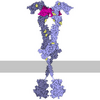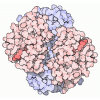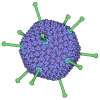+ Open data
Open data
- Basic information
Basic information
| Entry |  | |||||||||
|---|---|---|---|---|---|---|---|---|---|---|
| Title | Structure of human SIgA1 in complex with human CD89 (FcaR1) | |||||||||
 Map data Map data | ||||||||||
 Sample Sample |
| |||||||||
 Keywords Keywords | Secretory immunoglobulin A / SIgA / IgA / CD89 / FcaR1 / IgA Fc receptor / protein complex / IMMUNE SYSTEM | |||||||||
| Function / homology |  Function and homology information Function and homology informationIgA receptor activity / polymeric immunoglobulin receptor activity / immunoglobulin transcytosis in epithelial cells mediated by polymeric immunoglobulin receptor / polymeric immunoglobulin binding / dimeric IgA immunoglobulin complex / secretory dimeric IgA immunoglobulin complex / pentameric IgM immunoglobulin complex / monomeric IgA immunoglobulin complex / secretory IgA immunoglobulin complex / cellular response to interferon-alpha ...IgA receptor activity / polymeric immunoglobulin receptor activity / immunoglobulin transcytosis in epithelial cells mediated by polymeric immunoglobulin receptor / polymeric immunoglobulin binding / dimeric IgA immunoglobulin complex / secretory dimeric IgA immunoglobulin complex / pentameric IgM immunoglobulin complex / monomeric IgA immunoglobulin complex / secretory IgA immunoglobulin complex / cellular response to interferon-alpha / Fc receptor signaling pathway / immune response-regulating signaling pathway / IgA binding / positive regulation of neutrophil apoptotic process / IgA immunoglobulin complex / glomerular filtration / detection of chemical stimulus involved in sensory perception of bitter taste / neutrophil activation / cellular response to granulocyte macrophage colony-stimulating factor stimulus / IgG immunoglobulin complex / neutrophil mediated immunity / cellular response to interleukin-6 / immunoglobulin receptor binding / immunoglobulin complex, circulating / azurophil granule membrane / receptor clustering / positive regulation of respiratory burst / humoral immune response / tertiary granule membrane / ficolin-1-rich granule membrane / complement activation, classical pathway / Scavenging of heme from plasma / antigen binding / specific granule membrane / Cell surface interactions at the vascular wall / B cell receptor signaling pathway / cellular response to type II interferon / epidermal growth factor receptor signaling pathway / cellular response to tumor necrosis factor / antibacterial humoral response / transmembrane signaling receptor activity / cellular response to lipopolysaccharide / protein-containing complex assembly / protein-macromolecule adaptor activity / blood microparticle / adaptive immune response / receptor complex / immune response / innate immune response / Neutrophil degranulation / signal transduction / protein homodimerization activity / extracellular space / extracellular exosome / extracellular region / plasma membrane Similarity search - Function | |||||||||
| Biological species |  Homo sapiens (human) Homo sapiens (human) | |||||||||
| Method | single particle reconstruction / cryo EM / Resolution: 3.2 Å | |||||||||
 Authors Authors | Liu Q / Stadtmueller BM | |||||||||
| Funding support |  United States, 1 items United States, 1 items
| |||||||||
 Citation Citation |  Journal: Nat Commun / Year: 2023 Journal: Nat Commun / Year: 2023Title: SIgA structures bound to Streptococcus pyogenes M4 and human CD89 provide insights into host-pathogen interactions. Authors: Qianqiao Liu / Beth M Stadtmueller /  Abstract: Immunoglobulin (Ig) A functions as monomeric IgA in the serum and Secretory (S) IgA in mucosal secretions. Host IgA Fc receptors (FcαRs), including human FcαR1/CD89, mediate IgA effector functions; ...Immunoglobulin (Ig) A functions as monomeric IgA in the serum and Secretory (S) IgA in mucosal secretions. Host IgA Fc receptors (FcαRs), including human FcαR1/CD89, mediate IgA effector functions; however, human pathogen Streptococcus pyogenes has evolved surface-protein virulence factors, including M4, that also engage the CD89-binding site on IgA. Despite human mucosa serving as a reservoir for pathogens, SIgA interactions with CD89 and M4 remain poorly understood. Here we report cryo-EM structures of M4-SIgA and CD89-SIgA complexes, which unexpectedly reveal different SIgA-binding stoichiometry for M4 and CD89. Structural data, supporting experiments, and modeling indicate that copies of SIgA bound to S. pyogenes M4 will adopt similar orientations on the bacterium surface and leave one host FcαR binding site open. Results suggest unappreciated functional consequences associated with SIgA binding to host and bacterial FcαRs relevant to understanding host-microbe co-evolution, IgA effector functions and improving the outcomes of group A Streptococcus infection. | |||||||||
| History |
|
- Structure visualization
Structure visualization
| Supplemental images |
|---|
- Downloads & links
Downloads & links
-EMDB archive
| Map data |  emd_40567.map.gz emd_40567.map.gz | 306.8 MB |  EMDB map data format EMDB map data format | |
|---|---|---|---|---|
| Header (meta data) |  emd-40567-v30.xml emd-40567-v30.xml emd-40567.xml emd-40567.xml | 17.7 KB 17.7 KB | Display Display |  EMDB header EMDB header |
| Images |  emd_40567.png emd_40567.png | 73 KB | ||
| Filedesc metadata |  emd-40567.cif.gz emd-40567.cif.gz | 6.3 KB | ||
| Others |  emd_40567_half_map_1.map.gz emd_40567_half_map_1.map.gz emd_40567_half_map_2.map.gz emd_40567_half_map_2.map.gz | 301.6 MB 301.6 MB | ||
| Archive directory |  http://ftp.pdbj.org/pub/emdb/structures/EMD-40567 http://ftp.pdbj.org/pub/emdb/structures/EMD-40567 ftp://ftp.pdbj.org/pub/emdb/structures/EMD-40567 ftp://ftp.pdbj.org/pub/emdb/structures/EMD-40567 | HTTPS FTP |
-Validation report
| Summary document |  emd_40567_validation.pdf.gz emd_40567_validation.pdf.gz | 904.8 KB | Display |  EMDB validaton report EMDB validaton report |
|---|---|---|---|---|
| Full document |  emd_40567_full_validation.pdf.gz emd_40567_full_validation.pdf.gz | 904.4 KB | Display | |
| Data in XML |  emd_40567_validation.xml.gz emd_40567_validation.xml.gz | 17 KB | Display | |
| Data in CIF |  emd_40567_validation.cif.gz emd_40567_validation.cif.gz | 20.3 KB | Display | |
| Arichive directory |  https://ftp.pdbj.org/pub/emdb/validation_reports/EMD-40567 https://ftp.pdbj.org/pub/emdb/validation_reports/EMD-40567 ftp://ftp.pdbj.org/pub/emdb/validation_reports/EMD-40567 ftp://ftp.pdbj.org/pub/emdb/validation_reports/EMD-40567 | HTTPS FTP |
-Related structure data
| Related structure data |  8skuMC  8skvC M: atomic model generated by this map C: citing same article ( |
|---|---|
| Similar structure data | Similarity search - Function & homology  F&H Search F&H Search |
- Links
Links
| EMDB pages |  EMDB (EBI/PDBe) / EMDB (EBI/PDBe) /  EMDataResource EMDataResource |
|---|---|
| Related items in Molecule of the Month |
- Map
Map
| File |  Download / File: emd_40567.map.gz / Format: CCP4 / Size: 325 MB / Type: IMAGE STORED AS FLOATING POINT NUMBER (4 BYTES) Download / File: emd_40567.map.gz / Format: CCP4 / Size: 325 MB / Type: IMAGE STORED AS FLOATING POINT NUMBER (4 BYTES) | ||||||||||||||||||||||||||||||||||||
|---|---|---|---|---|---|---|---|---|---|---|---|---|---|---|---|---|---|---|---|---|---|---|---|---|---|---|---|---|---|---|---|---|---|---|---|---|---|
| Projections & slices | Image control
Images are generated by Spider. | ||||||||||||||||||||||||||||||||||||
| Voxel size | X=Y=Z: 0.822 Å | ||||||||||||||||||||||||||||||||||||
| Density |
| ||||||||||||||||||||||||||||||||||||
| Symmetry | Space group: 1 | ||||||||||||||||||||||||||||||||||||
| Details | EMDB XML:
|
-Supplemental data
-Half map: #2
| File | emd_40567_half_map_1.map | ||||||||||||
|---|---|---|---|---|---|---|---|---|---|---|---|---|---|
| Projections & Slices |
| ||||||||||||
| Density Histograms |
-Half map: #1
| File | emd_40567_half_map_2.map | ||||||||||||
|---|---|---|---|---|---|---|---|---|---|---|---|---|---|
| Projections & Slices |
| ||||||||||||
| Density Histograms |
- Sample components
Sample components
-Entire : human SIgA1 in complex with human CD89 (FcaR1)
| Entire | Name: human SIgA1 in complex with human CD89 (FcaR1) |
|---|---|
| Components |
|
-Supramolecule #1: human SIgA1 in complex with human CD89 (FcaR1)
| Supramolecule | Name: human SIgA1 in complex with human CD89 (FcaR1) / type: complex / ID: 1 / Parent: 0 / Macromolecule list: #1-#4 |
|---|---|
| Source (natural) | Organism:  Homo sapiens (human) Homo sapiens (human) |
-Macromolecule #1: Immunoglobulin heavy constant alpha 1
| Macromolecule | Name: Immunoglobulin heavy constant alpha 1 / type: protein_or_peptide / ID: 1 Details: The sequence of the Fab region is not included due to legal reasons. Number of copies: 4 / Enantiomer: LEVO |
|---|---|
| Source (natural) | Organism:  Homo sapiens (human) Homo sapiens (human) |
| Molecular weight | Theoretical: 37.687488 KDa |
| Recombinant expression | Organism:  Homo sapiens (human) Homo sapiens (human) |
| Sequence | String: ASPTSPKVFP LSLCSTQPDG NVVIACLVQG FFPQEPLSVT WSESGQGVTA RNFPPSQDAS GDLYTTSSQL TLPATQCLAG KSVTCHVKH YTNPSQDVTV PCPVPSTPPT PSPSTPPTPS PSCCHPRLSL HRPALEDLLL GSEANLTCTL TGLRDASGVT F TWTPSSGK ...String: ASPTSPKVFP LSLCSTQPDG NVVIACLVQG FFPQEPLSVT WSESGQGVTA RNFPPSQDAS GDLYTTSSQL TLPATQCLAG KSVTCHVKH YTNPSQDVTV PCPVPSTPPT PSPSTPPTPS PSCCHPRLSL HRPALEDLLL GSEANLTCTL TGLRDASGVT F TWTPSSGK SAVQGPPERD LCGCYSVSSV LPGCAEPWNH GKTFTCTAAY PESKTPLTAT LSKSGNTFRP EVHLLPPPSE EL ALNELVT LTCLARGFSP KDVLVRWLQG SQELPREKYL TWASRQEPSQ GTTTFAVTSI LRVAAEDWKK GDTFSCMVGH EAL PLAFTQ KTIDRLAGKP THVNVSVVMA EVDGTCY UniProtKB: Immunoglobulin heavy constant alpha 1 |
-Macromolecule #2: Secretory component
| Macromolecule | Name: Secretory component / type: protein_or_peptide / ID: 2 / Details: secretory component / Number of copies: 1 / Enantiomer: LEVO |
|---|---|
| Source (natural) | Organism:  Homo sapiens (human) Homo sapiens (human) |
| Molecular weight | Theoretical: 61.095578 KDa |
| Recombinant expression | Organism:  Homo sapiens (human) Homo sapiens (human) |
| Sequence | String: KSPIFGPEEV NSVEGNSVSI TCYYPPTSVN RHTRKYWCRQ GARGGCITLI SSEGYVSSKY AGRANLTNFP ENGTFVVNIA QLSQDDSGR YKCGLGINSR GLSFDVSLEV SQGPGLLNDT KVYTVDLGRT VTINCPFKTE NAQKRKSLYK QIGLYPVLVI D SSGYVNPN ...String: KSPIFGPEEV NSVEGNSVSI TCYYPPTSVN RHTRKYWCRQ GARGGCITLI SSEGYVSSKY AGRANLTNFP ENGTFVVNIA QLSQDDSGR YKCGLGINSR GLSFDVSLEV SQGPGLLNDT KVYTVDLGRT VTINCPFKTE NAQKRKSLYK QIGLYPVLVI D SSGYVNPN YTGRIRLDIQ GTGQLLFSVV INQLRLSDAG QYLCQAGDDS NSNKKNADLQ VLKPEPELVY EDLRGSVTFH CA LGPEVAN VAKFLCRQSS GENCDVVVNT LGKRAPAFEG RILLNPQDKD GSFSVVITGL RKEDAGRYLC GAHSDGQLQE GSP IQAWQL FVNEESTIPR SPTVVKGVAG GSVAVLCPYN RKESKSIKYW CLWEGAQNGR CPLLVDSEGW VKAQYEGRLS LLEE PGNGT FTVILNQLTS RDAGFYWCLT NGDTLWRTTV EIKIIEGEPN LKVPGNVTAV LGETLKVPCH FPCKFSSYEK YWCKW NNTG CQALPSQDEG PSKAFVNCDE NSRLVSLTLN LVTRADEGWY WCGVKQGHFY GETAAVYVAV EERHHHHHH UniProtKB: Polymeric immunoglobulin receptor |
-Macromolecule #3: Immunoglobulin alpha Fc receptor
| Macromolecule | Name: Immunoglobulin alpha Fc receptor / type: protein_or_peptide / ID: 3 / Number of copies: 2 / Enantiomer: LEVO |
|---|---|
| Source (natural) | Organism:  Homo sapiens (human) Homo sapiens (human) |
| Molecular weight | Theoretical: 23.615742 KDa |
| Recombinant expression | Organism:  Homo sapiens (human) Homo sapiens (human) |
| Sequence | String: QEGDFPMPFI SAKSSPVIPL DGSVKIQCQA IREAYLTQLM IIKNSTYREI GRRLKFWNET DPEFVIDHMD ANKAGRYQCQ YRIGHYRFR YSDTLELVVT GLYGKPFLSA DRGLVLMPGE NISLTCSSAH IPFDRFSLAK EGELSLPQHQ SGEHPANFSL G PVDLNVSG ...String: QEGDFPMPFI SAKSSPVIPL DGSVKIQCQA IREAYLTQLM IIKNSTYREI GRRLKFWNET DPEFVIDHMD ANKAGRYQCQ YRIGHYRFR YSDTLELVVT GLYGKPFLSA DRGLVLMPGE NISLTCSSAH IPFDRFSLAK EGELSLPQHQ SGEHPANFSL G PVDLNVSG IYRCYGWYNR SPYLWSFPSN ALELVVTAID GRAHHHHHH UniProtKB: Immunoglobulin alpha Fc receptor |
-Macromolecule #4: Immunoglobulin J chain
| Macromolecule | Name: Immunoglobulin J chain / type: protein_or_peptide / ID: 4 / Number of copies: 1 / Enantiomer: LEVO |
|---|---|
| Source (natural) | Organism:  Homo sapiens (human) Homo sapiens (human) |
| Molecular weight | Theoretical: 15.611458 KDa |
| Recombinant expression | Organism:  Homo sapiens (human) Homo sapiens (human) |
| Sequence | String: QEDERIVLVD NKCKCARITS RIIRSSEDPN EDIVERNIRI IVPLNNRENI SDPTSPLRTR FVYHLSDLCK KCDPTEVELD NQIVTATQS NICDEDSATE TCYTYDRNKC YTAVVPLVYG GETKMVETAL TPDACYPD UniProtKB: Immunoglobulin J chain |
-Macromolecule #6: 2-acetamido-2-deoxy-beta-D-glucopyranose
| Macromolecule | Name: 2-acetamido-2-deoxy-beta-D-glucopyranose / type: ligand / ID: 6 / Number of copies: 4 / Formula: NAG |
|---|---|
| Molecular weight | Theoretical: 221.208 Da |
| Chemical component information |  ChemComp-NAG: |
-Experimental details
-Structure determination
| Method | cryo EM |
|---|---|
 Processing Processing | single particle reconstruction |
| Aggregation state | particle |
- Sample preparation
Sample preparation
| Buffer | pH: 7 |
|---|---|
| Vitrification | Cryogen name: ETHANE / Chamber humidity: 100 % / Instrument: FEI VITROBOT MARK IV |
- Electron microscopy
Electron microscopy
| Microscope | FEI TITAN KRIOS |
|---|---|
| Image recording | Film or detector model: GATAN K3 (6k x 4k) / Average electron dose: 71.3 e/Å2 |
| Electron beam | Acceleration voltage: 300 kV / Electron source:  FIELD EMISSION GUN FIELD EMISSION GUN |
| Electron optics | Illumination mode: FLOOD BEAM / Imaging mode: BRIGHT FIELD / Nominal defocus max: 2.0 µm / Nominal defocus min: 0.8 µm |
| Experimental equipment |  Model: Titan Krios / Image courtesy: FEI Company |
- Image processing
Image processing
| Startup model | Type of model: PDB ENTRY PDB model - PDB ID: |
|---|---|
| Final reconstruction | Resolution.type: BY AUTHOR / Resolution: 3.2 Å / Resolution method: FSC 0.143 CUT-OFF / Number images used: 249000 |
| Initial angle assignment | Type: NOT APPLICABLE |
| Final angle assignment | Type: NOT APPLICABLE |
 Movie
Movie Controller
Controller




















 Z (Sec.)
Z (Sec.) Y (Row.)
Y (Row.) X (Col.)
X (Col.)





































